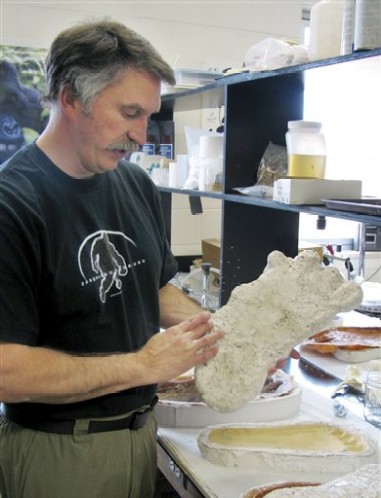
November 7, 2007
Some species have been described and accepted by science, merely from their footprints. This has occurred most famously with dinosaurs.
Jeff Meldrum, Ph. D., Idaho State University, has come forth with a new moniker by which we may talk about Sasquatch. But it is not a “new name” for Bigfoot. Meldrum has given the tracks a new label, Anthropoidipes ameriborealis (“North American ape foot”), in his just-published paper, “Ichnotaxonomy of Giant Hominid Tracks in North America.”
Meldrum sends along this:
“Point of clarification — Anthropoidipes ameriborealis is NOT a proposed name for sasquatch. It is a published name for tracks/footprints that have been attributed to Sasquatch. Ichnotaxonomy is a linnaean system for naming tracks and traces separate and distinct from the taxonomy of the organisms themselves. It can be applied even if the trackmaker has not been identified, hence its utility in this situation. The paper does not validate the existence of Sasquatch, but recognizes the existence of large unidentified tracks and puts a handle on them. This should also increase discussion of the footprint data.”

Meldrum’s abstract follows:
Abstract—Large bipedal hominoid footprints, commonly attributed to Bigfoot or sasquatch, continue to be discovered and documented, occasionally in correlation with eyewitness sightings, and rarely in concert with photographic record of the trackmaker (gen. et sp. indet.). One of the best-documented instances occurred in 1967, when Roger Patterson and Bob Gimlin filmed an over two meter tall upright striding hominoid figure, at the site of Bluff Creek, in Del Norte County, California, and cast a right and left pair of exceptionally clear footprints in firm moist sand. Additional footprints were filmed, photographed, and cast by multiple witnesses. Molds and casts of a series of these are reposited at the National Museum of Natural History, Smithsonian Institution, while ten original casts are among the Titmus Collection at the Willow Creek – China Flats Museum, Humboldt County, California. These casts have been 3D-scanned and archived as part of a footprint virtualization project and scan images are accessible on-line through the Idaho Museum of Natural History. The initial pair, originally cast by Patterson, and the remaining casts made by Titmus, are designated the holotype of a novel ichnogenus and ichnospecies describing these plantigrade pentadactyl bipedal primate footprints – Anthropoidipes ameriborealis (“North American ape foot”). The footprints imply a primitively flat, flexible foot lacking a stiff longitudinal arch, combined with a derived, non-divergent medial digit.
Download the paper here: Ichnotaxonomy of Giant Hominid Tracks in North America

There is a long history of formally attempting to tie Bigfoot to Latin scientific names. I posted an update of my examination of the subject in “Sasquatch Scientific Names.”
The late anthropologist Grover Krantz proposed for the Sasquatch, Gigantopithecus blacki, but had a backup moniker too. If in fact Bigfoot is a different species of this genus, then Krantz suggested naming it Gigantopithecus canadensis. As Grover Krantz pointed out, canadensis “is a commonly used zoological name for species that are native to northern North America.”
It appears Meldrum had similar thoughts, but went with ameriborealis and linked the genus name with the tracks. (I was delighted to see that despite past bouts with disinformation where attempts were made to besmear Meldrum’s name, he has trekked steadfastly right along and got published this ground-breaking peer-reviewed paper on Sasquatch tracks.)
Other choices than Meldrum’s, of course, may come into play if a living specimen or body shows any kind of alignment to previous fossil candidates. As long ago as 1971, Gordon Strasenburgh noted that Bigfoot would be found to be related to Paranthropus robustus. He proposed the name Paranthropus eldurrelli to be specifically used for the Pacific Northwest Bigfoot.
For other names that have been proposed for Bigfoot and other hairy unknown hominoids, please see here.
About Loren Coleman
Loren Coleman is one of the world’s leading cryptozoologists, some say “the” leading living cryptozoologist. Certainly, he is acknowledged as the current living American researcher and writer who has most popularized cryptozoology in the late 20th and early 21st centuries.
Starting his fieldwork and investigations in 1960, after traveling and trekking extensively in pursuit of cryptozoological mysteries, Coleman began writing to share his experiences in 1969. An honorary member of Ivan T. Sanderson’s Society for the Investigation of the Unexplained in the 1970s, Coleman has been bestowed with similar honorary memberships of the North Idaho College Cryptozoology Club in 1983, and in subsequent years, that of the British Columbia Scientific Cryptozoology Club, CryptoSafari International, and other international organizations. He was also a Life Member and Benefactor of the International Society of Cryptozoology (now-defunct).
Loren Coleman’s daily blog, as a member of the Cryptomundo Team, served as an ongoing avenue of communication for the ever-growing body of cryptozoo news from 2005 through 2013. He returned as an infrequent contributor beginning Halloween week of 2015.
Coleman is the founder in 2003, and current director of the International Cryptozoology Museum in Portland, Maine.
Filed under Bigfoot, Breaking News, Cryptomundo Exclusive, Cryptotourism, CryptoZoo News, Cryptozoologists, Cryptozoology, Evidence, Forensic Science, Men in Cryptozoology, New Species, Sasquatch